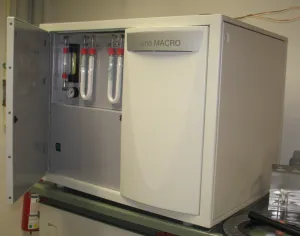Elemental analyzer
Vario Macro, Company Elementar
General principle
Catalytic combustion tube (combustion tube filled with tungsten oxide) with oxygen feed and at high temperatures. The sample components are separated through specialized adsorption columns. The sample matrix is destroyed through high temperatures (1150 °C), and is split into the elements to be examined through a catalytic reaction with O2.
C + O2 --> CO2
2 H2 + O2 --> 2 H2O
CO2, H2O, N2, SO2, and all leftover volatile gases such as O2 and halogens are removed from the gas flow through condensation and adsorption, are separated from each other, and are then determined on the WLD. The desorption temperatures are optimized in such a way that at low concentration, the element to be determined has the highest possible element concentration in the carrier gas after the desorption (purge and trap method).
Catalysis: When an organic or non-organic test decomposes, a change in the reaction speed of the chemical reaction, without a change in the thermodynamic equilibrium, takes place. Catalysts are substances that speed up a reaction at a constant temperature, without actually participating in the reaction itself. In other words, catalysts lower the activation energy of a chemical reaction.
Adsorption: The molecules of a gas stay on the surface of a different substance (adsorbents), and adhere to and accumulate on these substances. Adsorbents are: activated carbon, silica gel, molecular sieves (zeolites).
Carrier gas: Helium, carries the elements through the system, and takes no part in the reaction (inert).
Measurement principle
A thermal conductivity cell with Pt- or W-heating coals continuously measures the conductivity of the carrier gas with the hot wire method.
The WLD includes two identical cells in a thermostatic metal block. One cell is constantly flowed through by carrier gas, the other with the researched components (gases) and the carrier gas. The temperature of the wires, and through this, the electric resistance, depends on the conductivity of the gases that are flowing through the cells.
If the composition of the gases changes, the temperature, and through this the resistance in the wires in the measuring cell, also changes. The temperature in the measuring cell, which is only flowed through by helium, does not change. This temperature difference results in a measurable voltage difference. The signals are proportionate to the sample concentration in the carrier gas.
The WLD is usable for basically all substances, as long as they do not destroy it through corrosion.
